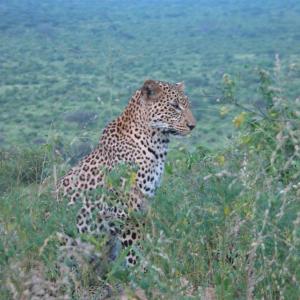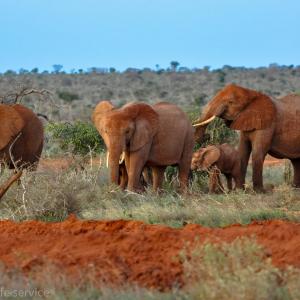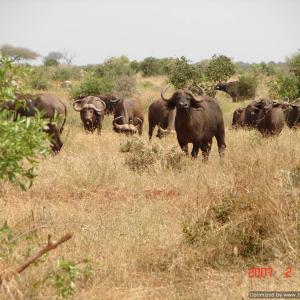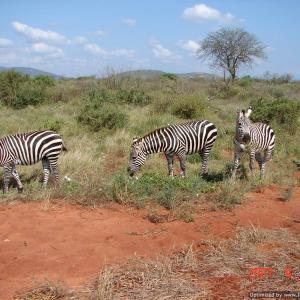“Theatre of the Wild”
The joint mass of Tsavo West and Tsavo East National Parks forms one of the largest national parks in the world and covers a massive 4% of Kenya’s total land area. Tsavo East, the larger of the two, lies equidistant between Nairobi and Mombasa and is one of the last great wilderness safari landscapes on Earth. A dramatically presented theatre of the wild, this Kenya safari destination offers a vast arena of parched scrub and heat-shimmering bush which is washed by the azure waters and emerald-fringed meanderings of the Galana River, guarded by the limitless lava reaches of the Yatta Plateau and patrolled by some of the largest safari elephant herds in the world.
Kenya Safari Fact File
Area: 11,747 sq. km.
Altitude: 150-1,200 metres above sea level
Location: Southeast Kenya, inland from the coast.
Climate: The Kenya safari travel climate is warm and dry, temperatures ranging from 20-40 degrees C, rainfall from 200mm-700mm per annum (the ‘long rains’ falling between March and May and the ‘short rains’ between October and December).
Vegetation: One of the globe’s last biodiversity strong holds, this Kenyan safari park features bushy grasslands, open plains, semi-arid acacia scrub and woodlands.
Mammals: Kenya wildlife safari sightings include lion, leopard, elephant, black rhino, hippo, giraffe, lesser kudu, oryx, Cape buffalo, zebra, yellow baboon, waterbuck, gemsbok, Coke’s hartebeest, gerenuk, and gazelle.
Birds: The prolific bird life features 500 recorded species.
Activities: elephant safaris, Kenya lodge safaris, Kenya safari camps, Kenya safari packages, family safaris. Thanks to its popularity, the park also offers a number of excellent Kenya safari tour options and Kenya safari packages.
Tsavo, what’s in a name?
The Park acquired its name ‘Tsavo’, meaning ‘slaughter’ from the Akamba people, who first migrated to the area some five centuries ago – long before the arrival of the more famous leonine slaughterers, the ‘Man-Eaters’ of Tsavo.
The legendary longbow men of the Waliangulu
Between 5,000 and 10,000 years ago, Tsavo was inhabited by the ancestors of today’s remnant groups of hunter-gatherers, primarily the Waliangulu or Sanye people who were wanderers of forest and bush and distantly related to the ‘click-speaking’ Khosian peoples of southern Africa, such as the Bushmen of the Kalahari. The Waliangulu, who were famous for their elephant hunting skills, used massive long bows and arrows that had been dipped in a lethal poison, which could kill an elephant in a few hours. The poison and was made by boiling the bark and leaves of the Acokanthera tree (Acokanthera oppositifolia ) for seven hours until a sticky tar like substance containing an extremely toxic glycoside known as ‘oubain’ was produced.
Glorious game drives
Tsavo East offers miles of open plains, bushy grassland and semi-arid scrub. What is more, once you depart off the few ‘beaten tracks’ that exist, you can explore one of the last remaining wildernesses on earth in almost primeval solitude.
Aruba Dam
The peacock-blue waters of Aruba dam, located on the north bank of the seasonal Voi River and contrasting vibrantly with the terracotta earth that surrounds them, are visited by thousands of animals making this an especially rewarding game-viewing destination. Aruba Dam is an 85-hectare man-made dam built by the Parks authorities in 1952 to staunch the waters of the seasonal Voi River, which flows down from the Taita Hills in the southwest. It usually holds water throughout the year and is frequented by huge numbers of ibis, many grey heron and a kaleidoscope of other water birds. It is also part of the territory of a large pride of lion, which can often be seen in the dam’s vicinity.
Kanderi Swamp
The Kanderi Swamp lies near Voi Gate and during the dry months provides one of only two drinking areas in Tsavo East, thus attracting large herds of buffalo, impala and antelopes as well as yellow baboons and lion.
Mudanda Rock
Kenya’s answer to Ayer’s Rock of Australia is called Mudanda Rock, a massive 1.5km whale-backed rock which rears out of the shrub between Manyani Gate and Voi and is famous for its photo-opportunities, offering marvellous light, panoramic vistas and an excellent chance of prime wildlife shots. It is also an excellent vantage point from which to look down on the natural dam below, which can at times attract hundreds of elephant. This area is also known as a favourite leopard haunt, though daytime sightings are rare.
The Galana River
The Tsavo and Athi Rivers join above Lugard’s Falls to form the Galana River, which then flows down to the Indian Ocean. A major feature of the park, the serpentine reaches of this river are fringed by riverine forests dominated by Acacia elatior, the Doum Palm Hyphaene compressa and the shrub Suaeda monoica.
Lugard’s Falls
Named after Britain’s first proconsul in East Africa, Captain (later Lord) Lugard, the falls are better described as rapids than falls progressing from foaming cataracts to narrow cascades that gouge deep into the gneiss bedrock creating fantastic shapes that have been surreally rounded by thousands of years of rushing water. Mighty when in full spate, the falls gush through a small fissure, narrow enough for the foolhardy to leap across, before plunging to the pool below, where massive crocodiles bask motionless in the sun. There is a parking area at the falls and visitors either climb around the bizarrely eroded rocks or walk down the river to view the rapids. 1km east of the falls another short diversion takes you to Crocodile Point where hippos and buffalo wallow and zip-jawed crocodile grin.
The Yatta Plateau, an ancient valley frozen in time
The Yatta plateau is a ridge or tongue of lava about 300km long and a maximum of 10km wide, which forms a seemingly never-ending backdrop to Tsavo East. One of the longest lava flows in the world, the Yatta affords fabulous views across the rolling reaches of the Park, is an ornithological paradise and makes a peerless sundowner or picnic spot. It is made up of a form of lava known as phonolite, which is between 11 and 13.6 million years old. Current thought suggests that the Yatta Plateau was formed when a stream of lava flowed across the land until it found its way into an ancient river valley. The lava then flowed down the valley; taking on the shape of its contours, until eventually it cooled and solidified. Thereafter the surrounding land was gradually lowered by erosion leaving the frozen river of lava standing up as a ridge.
Theatre of the wild
The sight of dust-red elephant wallowing, rolling and spraying each other with the midnight-blue waters of the Galana River is one of East Africa’s most evocative images. The rolling savannah is also dotted with rocky hills, the favoured haunt of lion, whilst the waterhole at Voi Safari Lodge is normally visited in the mornings by vast herds of buffalo, zebra and elephant. Giraffe are regulars along the Galana River routes as are troops of yellow baboon and numerous dik dik. Below Lugard’s Falls are Hippo Point and Crocodile Point, both of which are popular venues for wallowing hippo and basking crocodile. Small herds of the critically endangered Hirola (Hunter’s hartebeest) have also been translocated to the Park whilst the dry bush along the Galana River is a good place to look for one of Kenya’s most beautiful antelopes, the lesser kudu.
‘Man-eaters’ and mane-less lions
Tsavo achieved notoriety in the 1900’s when ‘the Man-eaters of Tsavo’, a pair of rogue man-eating lions, preyed gruesomely on the builders of the Uganda Railway. Today the Park is more famous for the numerous prides of mane-less lion that patrol the plains and police the herbivore herds. Lion can often be spotted near Kanderi Swamp and around Aruba Dam.
A brilliance of birds
Tsavo East’s prolific bird life features 500 recorded species. Commonly seen birds are African skimmer, goshawk, red and yellow bishop, palm nut vulture and the white-headed buffalo weaver. Around Aruba Dam there is also a profusion of woodpecker, sunbird, starling and pigeon whilst along the Galana River both Maasai and Somali ostrich abound along with kori bustard, bateleur, carmine bee-eater and an East African speciality, the vulturine guinea fowl.
| Economy | Voi Safari Lodge, Man Eaters Camp, Ngutani Safari Lodge, Zomeni Lion Hill Lodge |
| Comfort | Voi Wildlife Lodge, Ashnil Aruba Lodge, Sentrim Tsavo Camp, Kiboko Tented Camp |
| Luxury | Satao Camp |





